Public Outreach Observing Locations
Downtown Plaza de Las Cruces
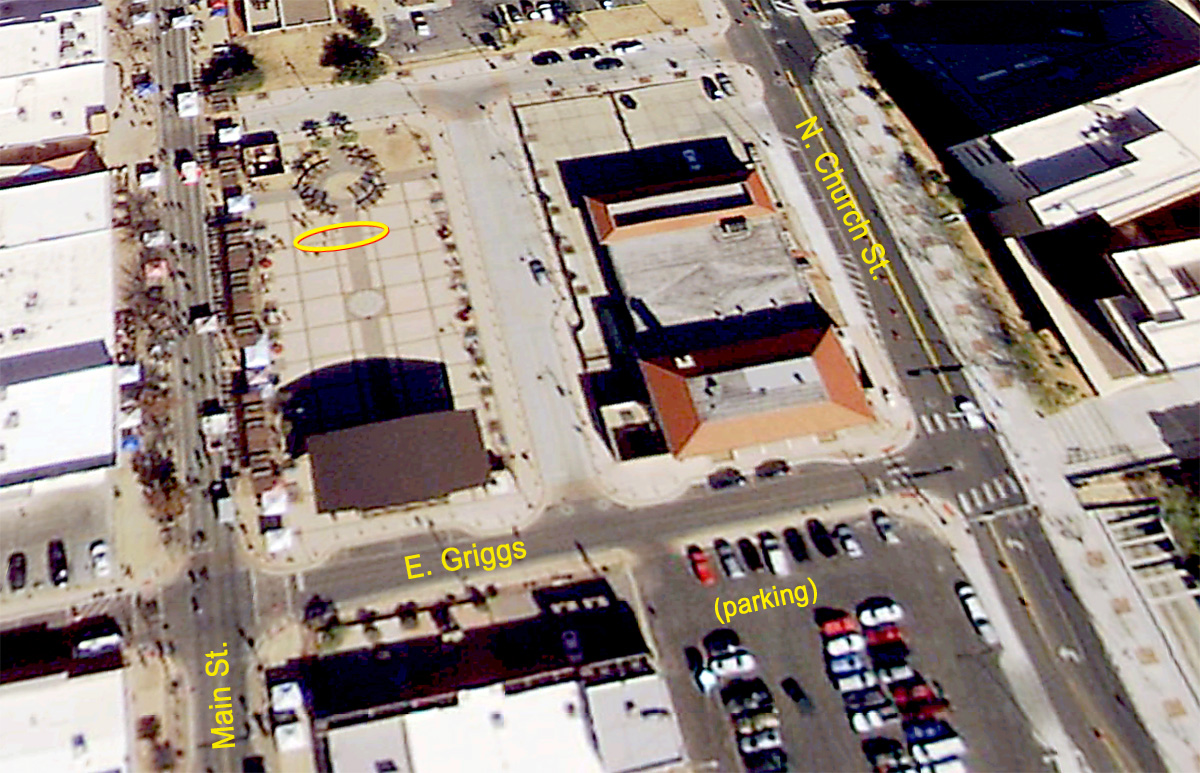 Each month on Saturday evenings closest to the first quarter Moon, ASLC conducts a free public viewing of the Moon and any bright planets (Mercury, Venus, Mars, Jupiter, Saturn) that are visible. One popular viewing location is The Las Cruces Downtown Plaza.
Each month on Saturday evenings closest to the first quarter Moon, ASLC conducts a free public viewing of the Moon and any bright planets (Mercury, Venus, Mars, Jupiter, Saturn) that are visible. One popular viewing location is The Las Cruces Downtown Plaza.
Weather permitting, our astronomers will set up toward the north end of the plaza - away from the stage (we'll likely be within the yellow highlighted oval region on the map to the right). Be sure to check the ASLC home page or the calendar page for the upcoming Moongaze date and location.
The image (right) shows the south side of the plaza looking north. Major streets are labeled. There is free public parking at the corner of E. Griggs & N. Church and another lot a block further north on N. Church. Clicking on the image opens a larger overview.
Farmer's Market / Museum of Nature & Science
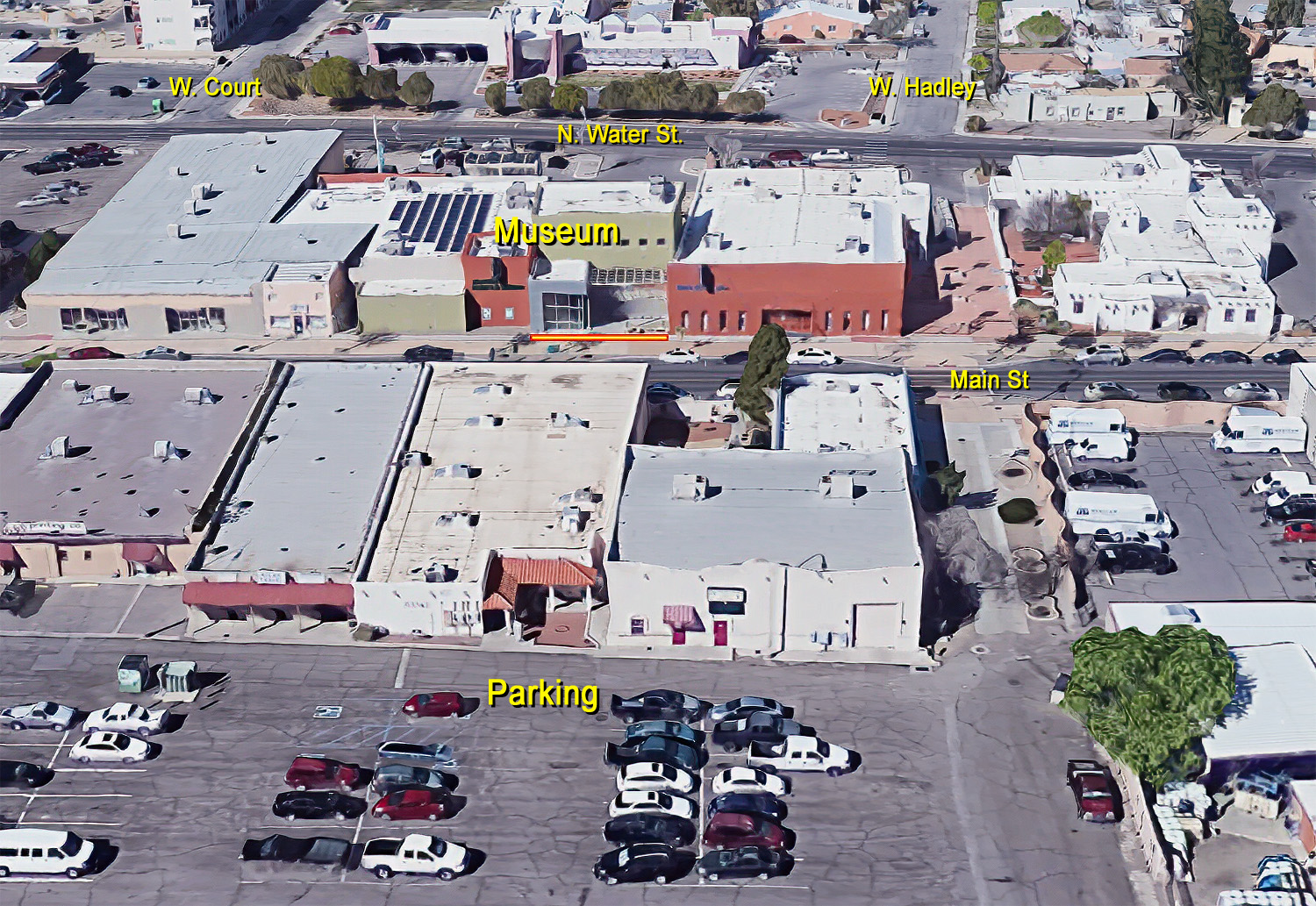 The club occasionally rolls out its solar telescopes for public outreach. We set up in downtown Las Cruces on Saturday mornings to coincide with the weekly Farmer's Market / Craft Show on Main Street. We've paired with the Las Cruces Museum of Nature & Science (411 N. Main Street). The museum has wonderful exhibits on space AND they have a great location right on Main Street for ASLC to set up our solar telescopes (marked with red/yellow on the map to the left - much easier to see in the full-size map).
The club occasionally rolls out its solar telescopes for public outreach. We set up in downtown Las Cruces on Saturday mornings to coincide with the weekly Farmer's Market / Craft Show on Main Street. We've paired with the Las Cruces Museum of Nature & Science (411 N. Main Street). The museum has wonderful exhibits on space AND they have a great location right on Main Street for ASLC to set up our solar telescopes (marked with red/yellow on the map to the left - much easier to see in the full-size map).
ASLC owns both 'single stack' and 'double stack' Coronado hydrogen alpha solar telescopes. They filter out all but a very narrow band of light - hydrogen alpha (656.28nm). It's the deep red color emitted by hydrogen atoms when an electron drops from its 3rd to its 2nd lowest energy state. With these telescopes, viewers can see solar prominences, filaments and other features normally obscured by the Sun's glare. We also have white light solar telescopes on hand as they are superior at highlighting sunspots.
When we're at the museum (check the outreach schedule), we're there from 10 am until around 1 pm (we might leave earlier during the heat of summer). If the line is short, patrons may try to take an image of the Sun with their smart phones. Please consult the attending astronomer before attempting to take a photo.
Clicking on the image will open a larger overview of the area (West is up).
Walter Haas Observatory at Leasburg Dam State Park
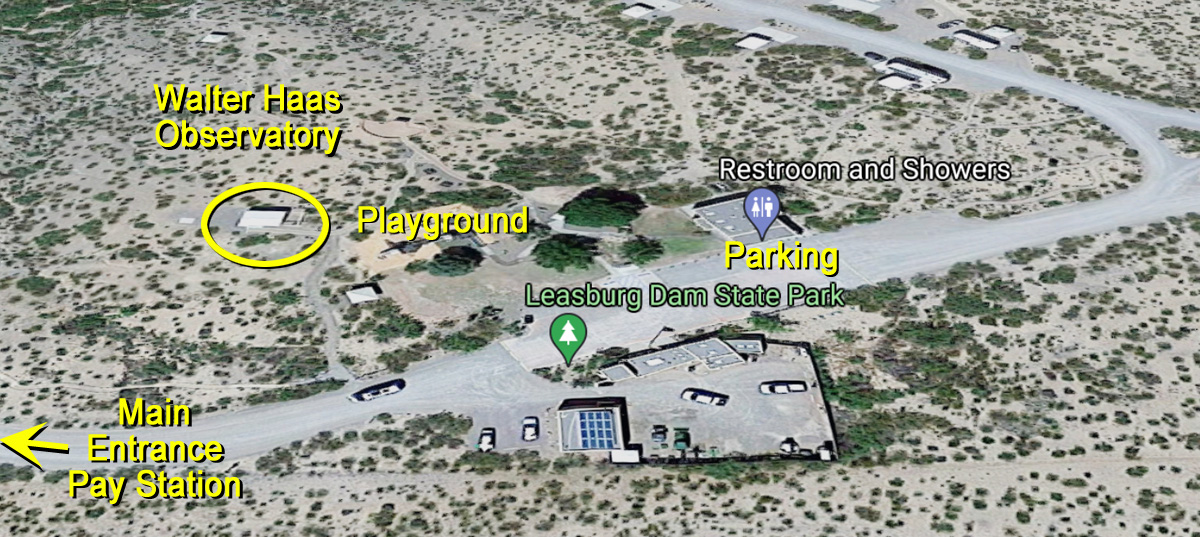 Leasburg Dam SP is a great local State Park along the Rio Grande River about 15 to 20 minutes north of Las Cruces on I-25 (turn West at Exit 19 and drive for about a mile before turning right/north into the park). The park offers hiking, camping, boating, fishing and swimming (when the river's running), birding and quiet. It is far enough away from the city's light dome to provide impressive views of dark sky objects.
Leasburg Dam SP is a great local State Park along the Rio Grande River about 15 to 20 minutes north of Las Cruces on I-25 (turn West at Exit 19 and drive for about a mile before turning right/north into the park). The park offers hiking, camping, boating, fishing and swimming (when the river's running), birding and quiet. It is far enough away from the city's light dome to provide impressive views of dark sky objects.
The park hosts a roll-off observatory that houses a 16" Meade LX-200 telescope (graciously provided by the NMSU Astronomy Department). ASLC members conduct dark sky observing each month on the Saturday evening closest to the third quarter Moon. Observing begins at dusk and is free to the public (park entrance fees apply). Additional viewing opportunities are offered by the park and by the club during the year. Check the park calendar or the ASLC calendar for updated information.
The observatory's namesake, the late Walter H. Haas, was a founding member of ASLC back in 1951. As a young man, Walter had a keen interest in observing the Moon and solar system objects which led him (in 1947) to found The Association of Lunar and Planetary Observers (ALPO). He was a huge advocate for the involvemen and value of amateur astronomers in the collection of valuable data regarding solar system objects. Sky and Telescope published an fitting tribute following Walter's passing. It can be found here.
Clicking on the image will open a larger overview of the area (West is up).
Gene & Elizabeth Simon Observatory at City of Rocks State Park
City of Rocks SP encompasses a one square mile area in the Chihuahuan desert region of southwestern New Mexico at an elevation of 5,200 feet. The “city” is a geologic formation made up of large, sculptured rock columns, or pinnacles, rising as high as 40 feet and separated by paths or lanes resembling city streets. Located about halfway between Silver City and Deming, the park offers camping, hiking, mountain biking, wildlife viewing, birding, and Bortle 2 (very dark) skies. Faywood Hot Springs abuts the west side of the park.
The park features a dedicated observatory with an ADA-accessible Meade 14" telescope. The observatory is located within the Orion Group Camping area. ASLC-'west' volunteers host monthly observing events at the park, usually on Saturday nights close to the new moon. Check the park calendar or the ASLC calendar for updated information.
Directions: Take highway US-180 north from Deming, NM or south from Silver City, NM to State Rt 61. Turn east on SR-61 (only option) and drive 3.2 miles to park entrance. Turn left (north) into park.
Clicking on the image on the right will open a larger overview of the area (NW is up).
Rockhound State Park
Rockhound is a unique State Park located 7 miles (11 km) southeast of Deming, NM. It is named for the abundance of minerals in the area. Visitors can collect and legally remove up to 15 pounds (per person) of quartz crystals, geodes, jasper, perlite, and many other minerals. The rugged slopes of the Little Florida Mountains are the setting for this park, which boasts hiking trails, unique geology, wildflower displays, a playground and a peaceful campground. Park elevation is 4,500 to 5,400 ft. Bortle 2-3 skies.
Observing sessions are held adjacent to the park Visitor Center. ASLC-'west' volunteers do a laser-guided sky tour at the beginning of each month's viewing session. Visitors are then welcome to look thru telescopes at available planets and seasonal deep sky objects. Check the park calendar or the ASLC calendar for updated information.
Directions: Take highway SR-549 east from Deming or exit from I-10 onto SR-549 (westbound) if coming from Las Cruces. Turn south onto SR-143. After about 2.5 miles, turn left onto SR-198 (Stirrup Rd) and enter the park.
Clicking on the image on the right will open a larger overview of the area (SE is up).
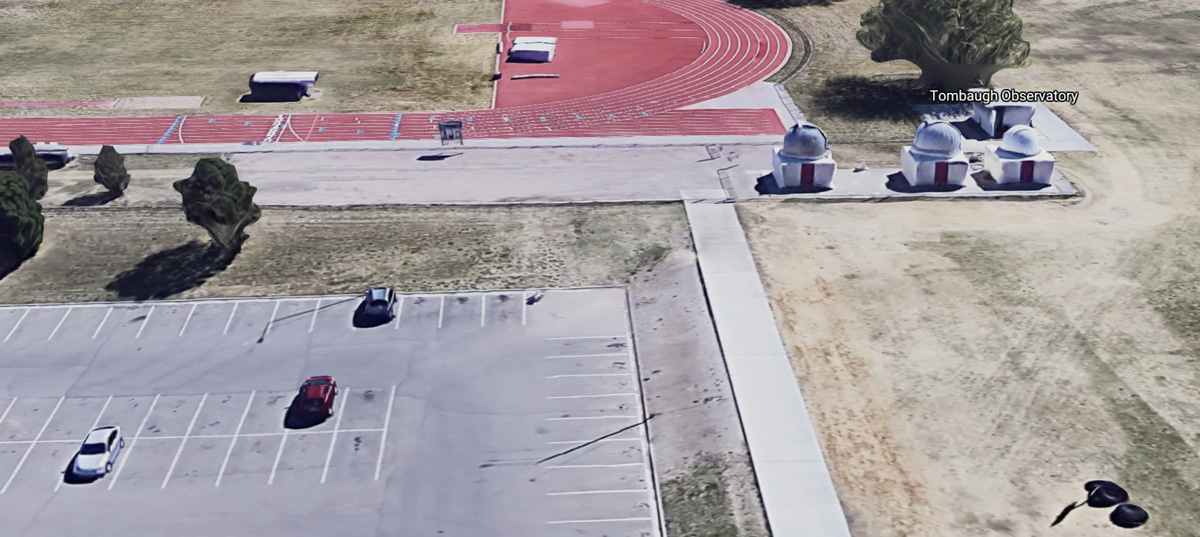 Clyde Tombaugh Observatory at New Mexico State University
Clyde Tombaugh Observatory at New Mexico State University
ASLC operates a domed observatory on the NMSU campus that encloses a 12" telescope. The scope was built from a rocket body acquired from White Sands Proving Ground. It is guided by a 1895 Grubbs of Dublin gravity driven mount. The scope may be used by ASLC members who have been trained in its operation.
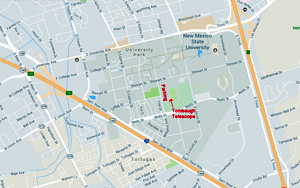 The observatory is primarily used during special public events on the NMSU campus. NMSU operates the adjacent observatories during public 'open houses' (usually on the Friday evening closest to each month's first quarter moon).
The observatory is primarily used during special public events on the NMSU campus. NMSU operates the adjacent observatories during public 'open houses' (usually on the Friday evening closest to each month's first quarter moon).
Finding the Observatory is easy. It's located on the southwest corner of the NMSU track. There is free parking available in the evening (after 5 pm). Enter the parking lot from Williams Ave. Use these the map to the right to help you find the observatory.
The Tombaugh observatory is the rightmost dome in this image (looking East). NMSU operates the two adjacent observatories for education and public outreach. Note that the overview picture is dated. Chain link fences surround the track and observatory areas. Access is usually limited to outreach events.
Clicking on the map or overview will open up a larger image.
-
-

